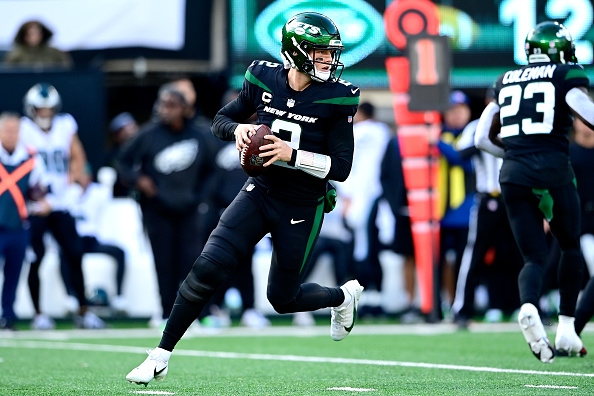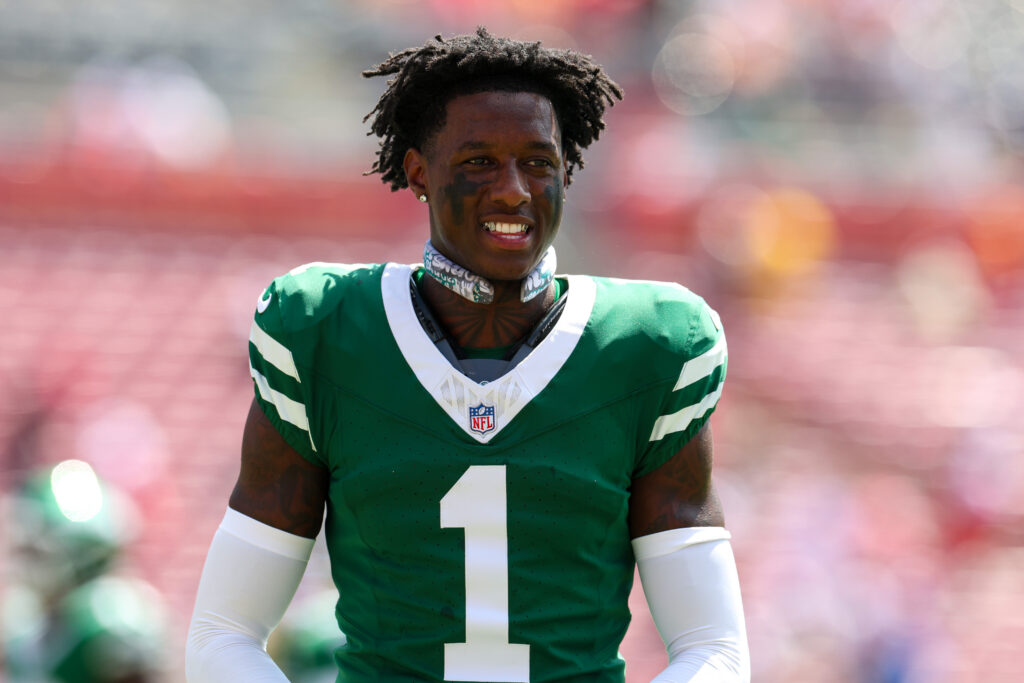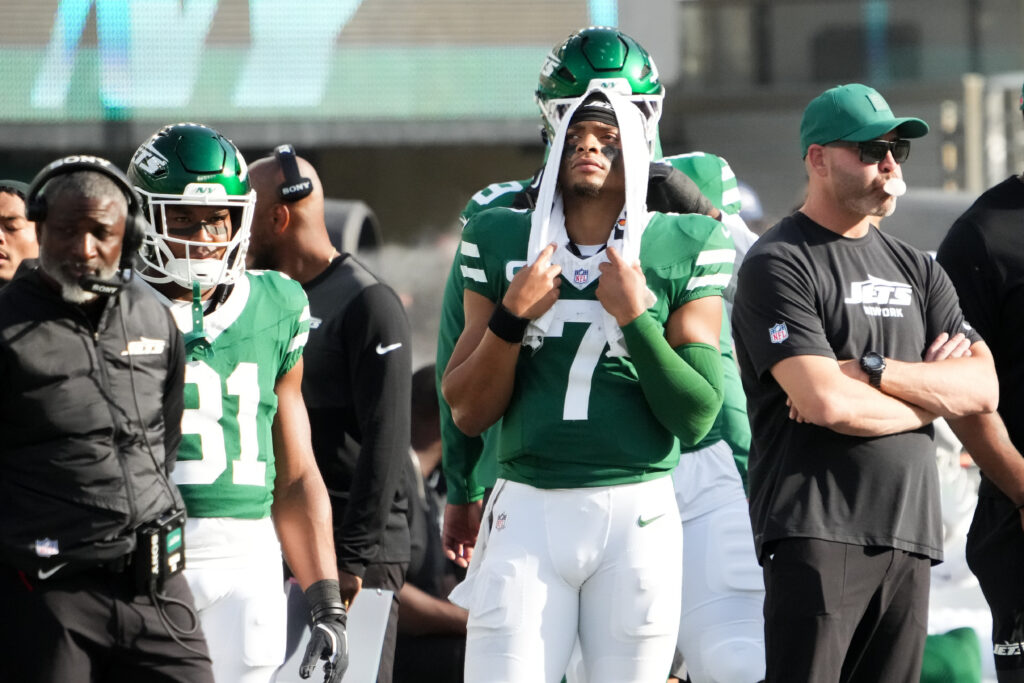New York Jets quarterback Zach Wilson looked good against the Miami Dolphins on Sunday. Despite the loss, the rookie exemplified progress in his development.
The casual football fan will tell you that no quarterback can succeed with the Jets because of their long history of terrible quarterbacks. If this new regime can secure the offensive side of the ball in the offseason, Zach Wilson will be set up for success. Next year could also be the year where the Jets starts competing.
Here are some of the reasons why Jets quarterback Zach Wilson has been set up for success.
New York Jets Quarterback Zach Wilson Can Succeed
Offensive Coordinator Mike LaFleur
Jets offensive coordinator Mike LaFleur is arguably the team’s best assistant coach. He is one of the bigger reasons why the team’s offense has continued to progress.
Early on in the season, fans wanted LaFleur axed for his awful play-calling, and with good reason. The emphasis of his play-calling early in the season was based on long-developing, play-action passes. The decision-making and accuracy of Wilson were suspect. The constant issue was Wilson was not getting into a rhythm.
Another weakness of Mike LaFleur’s was personnel usage. Former second-round pick Denzel Mims barely saw time on the field and that drew ire from the fans. Mims produced a solid rookie season last year despite injuries and less than league-average quarterback play. In nine games, he recorded 23 receptions for 357 yards for 15.5 yards per reception. Now, the limited playing time seems justified.
Second-round Ole Miss product Elijah Moore was also barely getting any touches on offense.
The constant runs on first and on second down long gave fans nightmares reminiscent of the Adam Gase era.
Mike LaFleur Goes Up To The Booth
But that all changed after the Week 7 contest against the New England Patriots. Zach Wilson left the game with a knee injury during the second quarter after taking a low hit from Patriots linebacker Matthew Judon. Mike White came in to replace Wilson and finish the game playing in the role of mop-up duty.
The Jets then announced that White would start Week 8 versus the Cincinnati Bengals. It was also revealed during the week that Mike LaFleur would call plays from the booth as opposed to the sideline. Wilson liked having LaFleur on the sidelines because he felt he needed a mentor to talk to in case of confusion. The team’s offensive coordinator felt more comfortable in the booth and boy did that play a factor in Week 8’s victory versus the Bengals.
The Jets’ game plan was solely based on running the ball effectively and getting the ball out quick with short, horizontal passing plays. The offense also got more creative with some trick plays like end-arounds and a featured flea-flicker or two. Those short passing plays ate away slowly at the Bengals’ defense and led them to victory.
Rookies Elijah Moore and Michael Carter were the featured weapons as both players combined for 15 receptions and 162 yards in the receiving game. Let me also mention that Mike White isn’t a vertical passer but the important thing to note is they didn’t force anything downfield and stuck to the quarterback’s strengths. The game plan also stuck to the strengths of the young weapons. Elijah Moore would go on a tear after his Week 8 performance.
In September, the Jets ranked at the bottom of the league in most offensive rankings. In four games with Zach Wilson out, the offense averaged 24.5 points and averaged 435 yards. The offense now stands at 24th in the league. That might not seem
I personally feel that with the set game plans, Mike LaFleur is putting Jets quarterback Zach Wilson in a position to succeed. LaFleur has evolved into a much more creative and innovative play-caller and is drawing up easy completions for his rookie quarterback.
Jets get creative on 3rd & 15! #TakeFlight
📺: #NYJvsMIA on CBS
📱: NFL app pic.twitter.com/ZFWPFNUxLq— NFL (@NFL) December 19, 2021
Weapons and Offensive Line
Unlike Sam Darnold‘s first year, New York Jets quarterback Zach Wilson has more reliable weapons to pass to as well as better protection upfront.
Running Backs
Let’s start with the running game. Although the NFL is a passing league, Sam Darnold never had a consistent run game that could take the pressure off of him. In his rookie season, Darnold had Isaiah Crowell and Bilal Powell in the backfield. Crowell only rushed for 100 yards or more twice. Those two backs barely combined for over 100 yards rushing. Both ended the season on injured reserve.
Because of those injuries, Darnold found himself next to third string and practice squad running backs. Regardless, the team’s rushing attack ranked 25th in the league, averaging 101.4 yards per game.
In 2019, Sam Darnold was supposed to get a huge boost in the backfield with Le’Veon Bell coming over from the Pittsburgh Steelers. He also missed a year due to a contract dispute with Pittsburgh. Bell looked rusty after missing a season and was also victim to Adam Gase’s horrific scheming purposely putting him in situations where he’d fail. The rushing offense ranked 31st in the NFL, averaging 78.6 yards on the ground per game.
The Jets’ rushing attack also ranked at the bottom of the league in 2020 with 37-year old Frank Gore leading the team in rushing yards.
To get Zach Wilson some help in the backfield, the Jets drafted North Carolina product, Michael Carter. From just six yards in Week 1 versus the Carolina Panthers, Carter is now the team’s lead running back for now and the foreseeable future. On the season, he’s recorded 448 rushing yards on 119 rushing attempts, averaging 3.8 yards per carry with four touchdowns. Carter has also been extremely effective in the pass game as he’s caught 33 passes for 310 yards, totaling 9.4 yards per reception.
Jets quarterback Zach Wilson and rookie running back Michael Carter are growing together and have the chance to form some chemistry. The Jets also have reliable pieces behind Carter in veteran Tevin Coleman and Ty Johnson. When Sam Darnold was with the Jets, there was constant turnover in the backfield with many different backs getting the carries.
Wide Receivers and Tight Ends
Comparing wide receivers and tight ends that Zach Wilson and Sam Darnold had in their rookie seasons, Wilson again has the edge.
The Jets signed Corey Davis to a three-year contract in free agency. Veteran receiver Keelan Cole also signed for a one-year deal. Then, the Jets drafted Ole Miss product Elijah Moore early in the second round. Moore, despite being on IR, arose as the team’s best receiver. The ever-reliable Jamison Crowder has been a mainstay since Sam Darnold’s sophomore season.
For Sam Darnold’s rookie season, his starting receivers were Quincy Enunwa, Robby Anderson, and Jermaine Kearse. That season the Jets also drafted tight end Chris Herndon. Darnold formed nice chemistry with Enunwa until he went on injured reserve. During the middle of the season, both Sam Darnold and Chris Herndon formed a nice rookie rapport giving fans hope for the future. Herndon recorded 39 receptions and 502 yards for four touchdowns. Unfortunately, he was never the same after his rookie season.
Robby Anderson also formed a connection with Sam Darnold towards the end of the season which would lead into 2019. Anderson put up back-to-back 700-yard seasons. But in comparison to Zach Wilson’s rookie season, the Jets top weapons weren’t healthy on a consistent basis leading Sam Darnold to throw to bottom-of-the-depth-chart receivers.
[pickup_prop id=”17352″]
The Jets then added the aforementioned Jamison Crowder in 2019. The team never had a true WR3 after Quincy Enunwa accumulated a season-ending injury after just one game. Tight end Ryan Griffin was added in July after Chris Herndon was handed a suspension. Griffin became Darnold’s security blanket as he recorded 34 receptions for 320 yards and five touchdowns.
The same could be said for 2020 when the Jets replaced Robby Anderson with an underachieving Breshad Perriman.
Sam Darnold had his weapons but never had a true number one receiver. In addition, he didn’t have a good offensive mind like Mike LaFleur.
Offensive Line
The worst part of Sam Darnold’s supporting cast was his offensive line. In his rookie season, Football Outsiders ranked the Jets’ offensive line the worst in the league. The unit gave up 37 sacks, which actually is below the league average of 40. They also finished 18th in pass protection. Those stats all look decent but if you watched the games Sam Darnold saw pressure in his face on a high percentage of the snaps he took. It didn’t help that the offensive line was the most penalized unit on the team.
Free agent acquisition Spencer Long became a liability in pass protection and at times had trouble snapping the ball. Backup center Jonotthan Harrison outplayed Long by a mile. Left tackle Kelvin Beachum gave up six sacks on Darnold’s blindside, although he was the biggest constant on the unit. Injuries also ravaged the unit as Sam Darnold did not enjoy playing behind backups.
In 2019, the Jets played with an overwhelming amount of offensive line combinations. The team played with a total of nine. The team made upgrades by trading for Kelechi Osemele and pulling five-time Pro Bowl center Ryan Kalil out of retirement. They also made a depth move by trading for Alex Lewis in August. But with much less continuity, came heavy regression. Osemele was cut mid-season after undergoing surgery the team didn’t approve.
Ryan Kalil was a shell of himself and eventually finished the season on injured reserve. The unit surrendered 52 sacks, ranking third worst in the league. The adjusted sack rate also ranked third-worst at 9.2 percent. The unit also allowed pressure in 2.5 seconds or less on 27 percent of dropbacks which ranked second-highest in the NFL.
The Jets went back to work on the offensive line in 2020, adding multiple pieces like center Connor McGovern and guard Greg Van Roten. They also drafted Louisville tackle Mekhi Becton at 11th overall. Former Seattle Seahawk George Fant was also signed to play right tackle. Coming into 2020, no starters on the line remained from Week 1 of the previous season.
With those upgrades, the line got better but not by much. The team allowed 43 sacks and an adjusted sack rate of 8.1 percent, both ranking fifth worst in the league. The unit allowed pressure in 2.5 seconds or less on 28 percent of their dropbacks, ranking worst in the NFL. If there was any progress for this unit, it was miniscule. The only linemen that played legitimately well were George Fant and rookie Mekhi Becton.
Zach Wilson’s Offensive Line
The Jets made two changes to their offensive line this offseason by drafting USC guard Alijah Vera-Tucker and signing veteran tackle Morgan Moses. The offensive line dealt with adversity as early as Week One versus the Carolina Panthers. Mekhi Becton left the game with a knee injury and hasn’t returned to game action since.
I personally believe this unit reached league average status after trading for Kansas City Chiefs offensive lineman Laurent Duvernay-Tardif. He made his first start in Week 11 versus the Miami Dolphins and looked rusty but has shown progress in recent weeks. The unit has allowed 36 sacks but the eyes tell the far better story. This unit has shown to be a tad inconsistent but can really hold their own at their best.
George Fant has only given up one sack in 809 snaps. Alijah Vera-Tucker is a phenomenal run-blocker. Earlier in the season, he struggled in pass protection, allowing 38 pressures on the season. But, it seems he’s cleaned up that area of his game. Connor McGovern has been better with Duvernay-Tardif to his right but that’s not saying much. Morgan Moses has been average to above average on the right side.
What Can The Jets Do To Improve The Offense Next Year?
The New York Jets will have holes on the offensive side of the ball next season with some important players leaving for free agency.
Slot receiver Jamison Crowder is unlikely to come back with the emergence of Elijah Moore. Both Laurent Duvernay-Tardif and Morgan Moses are impending free agents which will leave a hole on the right side of the offensive line. Factor in a possible cap release of Greg Van Roten which would save the team around $3.5 million. Tight end Tyler Kroft is also an unrestricted free agent after season’s end.
This leaves the third wide receiver and lead tight end positions open with the right side of the offensive line vacant. If the Jets are serious about building around Zach Wilson, Ryan Griffin won’t be the lead tight end heading into next season. The Jets have many options they can go with to fill those holes via free agency or draft. Keep in mind, the team has glaring needs on the defensive side of the ball. The offense just needs a little tweaking.
The team will have approximately $48.2 million in cap space for 2022, per Over the Cap. Here are some offensive players the Jets can pursue in free agency:
- WR3: Mike Williams, Chris Godwin, Allen Robinson, Davante Adams, DJ Chark
- TE1: C.J. Uzomah, Gerald Everett, Zach Ertz, David Njoku
- RG: Mark Glowinski, Laurent Duvernay-Tardif (re-sign), James Daniels, Austin Corbett
- RT: Morgan Moses (re-sign), Trent Brown
2022 Draft
In the 2022 draft, the Jets will have nine selections with five of them being in the top 100 and two of them likely being in the top 10.
Due to the many holes on defense, the team will not likely take a swing at Trent Brown as he’ll be allocating plenty of money. To fill the right tackle hole, the Jets should draft Alabama tackle Evan Neal, if available. Neal is the best offensive lineman in the 2022 draft to date. His athleticism is what separates him from other linemen in his class. He offers versatility with experience playing left guard but there is concern with his size.
Neal stands at 350 lbs and the Jets would have two big lineman with weight concerns operating the tackle positions opposite each other. The team is already dealing with an injured Mekhi Becton who still hasn’t fully recovered from surgery that repaired cartilage damage in his knee. To me, the reward is too high to pass up and the Jets must grab Neal at fourth overall.
Although there are some attractive options in free agency, the best way to upgrade the tight end position is through the draft. Zach Ertz and David Njoku have injury concerns. Gerald Everett is a solid tight end but doesn’t move the needle too much.
Jalen Wydermyer is the best tight end of this class and he’s a must-get for a young quarterback. Wydermyer is a crisp route-runner and has a full route tree. His athleticism allows him to be a vertical threat. He also is an excellent jump-ball receiver making him a red zone target. The Jets could use one of their second-round picks on the young tight end to help out Zach Wilson.
In terms of the receiving game, the Jets can attack either free agency or draft. Luckily, there’s an abundance of good receivers throughout this draft. The team already has a WR1 in Elijah Moore. Corey Davis is the Jets big-body receiver that could go up for 50/50 balls.
Popular receivers the Jets can target in the early to mid-rounds are John Metchie III, Jahan Dotson, Justyn Ross, and George Pickens. Metchie and Dotson pose as good route-runners with elusive speed. Ross and Pickens won’t beat the opposition downfield with breakaway speed but with arm extension and good route-running horizontally.
Jets quarterback Zach Wilson has a good offensive coordinator and nice weapons in Corey Davis and Elijah Moore. He also has a near-league-average offensive line that can protect him. With their resources, the Jets can put the finishing touches on Wilson’s supporting cast and put him in a position to succeed. The franchise has the chance to right several previous failures.
Jets quarterback Zach Wilson will also have to take the next step in his development.
Main Photo:



